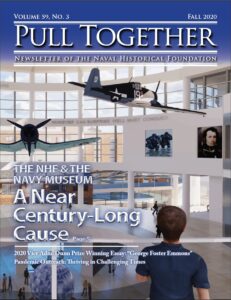By David F. Winkler, Ph.D.
Staff Historian
Finally on the morning of Saturday November 18, Cdr. Kenneth Whiting, the executive officer of the USS Langley, climbed into the cockpit of a PT seaplane which was positioned on that trolley contraption connected to the end of the catapult that had been installed on the flying deck of the U.S. Navy’s first aircraft carrier that was nicknamed “Little David.” What he was attempting to do would not go unnoticed. An hour earlier, representatives from five different motion picture companies set up their cameras alongside those of the Navy as the ship remained anchored in the York River. Not only did the Bureau of Naval Aeronautics Rear Adm. William A. Moffett arrive, but other notables came down from Washington including Capt. Emory Land to view the event. At 11:38 a.m. the deck log recorded “T.P. A—6048 was successfully launched from the catapult with Comdr. K. Whiting as pilot” – the first “cat shot” from a carrier in U.S. naval aviation history, much to the relief of those who watched the aircraft descend from view from the edge of the flying deck and count endless seconds until the seaplane came back in view.
It was not a flawless evolution. Whiting turned the engine up to full power and the PT roared down the deck. Apparently, lift on the seaplane’s wings caused the aircraft to foil the trip-release mechanism the Lt. Frederick W. “Horse” Pennoyer had built into his trolley contraption. Whiting succeeded in getting airborne, unaware, to Pennoyer’s horror, that bottom planking for both of his pontoons remained up on the focsile still attached to the trolley.
With Whiting flying the plane around Langley, with hands on deck pointing up to him to alert him of the damaged pontoons. With Langley’s crane swung out in anticipation of hoisting Whiting and the PT back aboard, calmly landed and pulled up under the crane hook, latching on before water had a chance to fill to pontoons. Langley’s crane then hauled the plane out of the York River.
With news of Whiting’s successful cat shot, Moffett would go before the House Appropriations Committee on November 22, to make a case for additional funding. He noted what that the British were still well ahead with regards to carrier aviation but the United States had a lead with regards to naval aviation on ships in general – given the number of catapults that were being installed on battleships and cruisers with an aim towards deploying aircraft to destroyers and submarines.
For a view of the catapult and a later takeoff by “Horse” Pennoyer see: www.youtube.com/watch?v=YthjqlK_xUk

